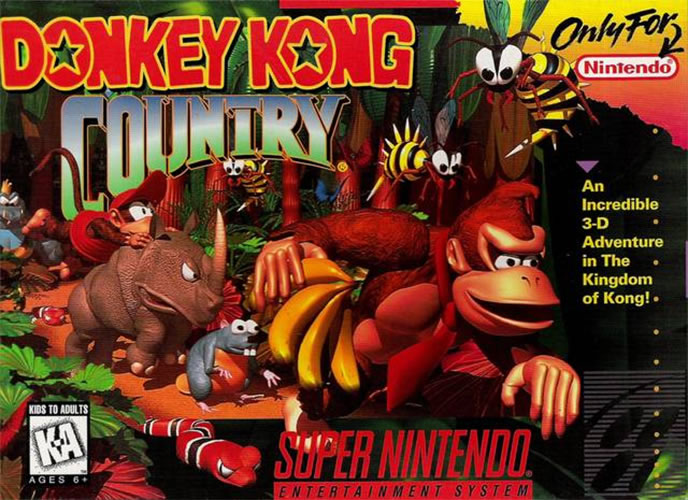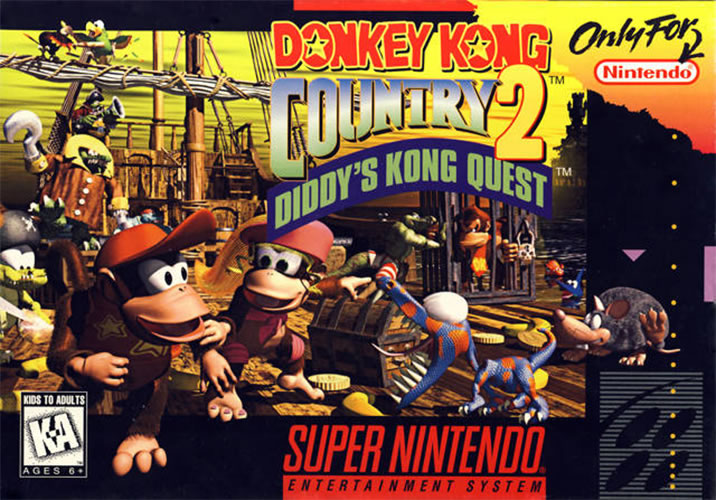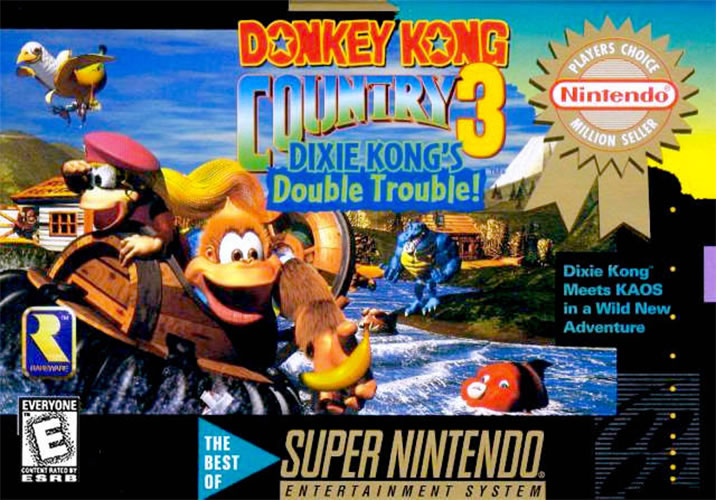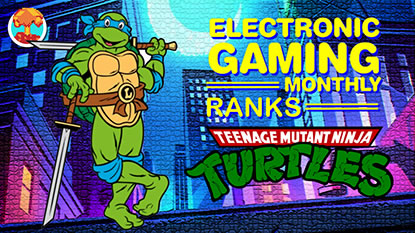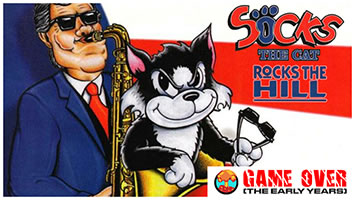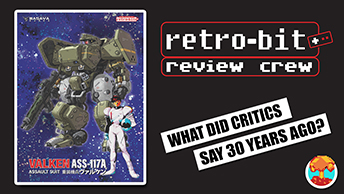- CLASSIC MAGAZINES
- REVIEW CREW
A show recapping what critics thought back
when classic games first came out! - NEXT GENERATION'S BEST & WORST
From the worst 1-star reviews to the best
5-stars can offer, this is Next Generation! - NINTENDO POWER (ARCHIVE)
Experience a variety of shows looking at the
often baffling history of Nintendo Power! - MAGAZINE RETROSPECTIVE
We're looking at the absolutely true history of
some of the most iconic game magazines ever! - SUPER PLAY'S TOP 600
The longest and most ambitious Super NES
countdown on the internet! - THEY SAID WHAT?
Debunking predictions and gossip found
in classic video game magazines! - NEXT GENERATION UNCOVERED
Cyril is back in this spin-off series, featuring the
cover critic review the art of Next Generation! - HARDCORE GAMER MAGAZING (PDF ISSUES)
Download all 36 issues of Hardcore Gamer
Magazine and relive the fun in PDF form!
- REVIEW CREW
- ELECTRONIC GAMING MONTHLY
- ELECTRONIC GAMING MONTHLY RANKS
From Mario to Sonic to Street Fighter, EGM
ranks classic game franchises and consoles! - ELECTRONIC GAMING MONTHLY BEST & WORST
Counting down EGM’s best and worst reviews
going year by year, from 1989 – 2009! - ELECTRONIC GAMING BEST & WORST AWARDS
11-part video series chronicling the ups and
downs of EGM’s Best & Worst Awards!
- ELECTRONIC GAMING MONTHLY RANKS
- GAME HISTORY
- GAME OVER: STORY BREAKDOWNS
Long-running series breaking down game
stories and analyzing their endings! - A BRIEF HISTORY OF GAMING w/ [NAME HERE]
Real history presented in a fun and pithy
format from a variety of game historians! - THE BLACK SHEEP
A series looking back at the black sheep
entries in popular game franchises! - INSTANT EXPERT
Everything you could possibly want to know
about a wide variety of gaming topics! - FREEZE FRAME
When something familiar happens in the games
industry, we're there to take a picture! - I'VE GOT YOUR NUMBER
Learn real video game history through a series
of number-themed episodes, starting at zero! - GREAT MOMENTS IN BAD ACTING
A joyous celebration of some of gaming's
absolute worst voice acting!
- GAME OVER: STORY BREAKDOWNS
- POPULAR SHOWS
- DG NEWS w/ LORNE RISELEY
Newsman Lorne Riseley hosts a regular
series looking at the hottest gaming news! - REVIEW REWIND
Cyril replays a game he reviewed 10+ years
ago to see if he got it right or wrong! - ON-RUNNING FEUDS
Defunct Games' longest-running show, with
editorials, observations and other fun oddities! - DEFUNCT GAMES QUIZ (ARCHIVE)
From online quizzes to game shows, we're
putting your video game knowledge to the test!- QUIZ: ONLINE PASS
Take a weekly quiz to see how well you know
the news and current gaming events! - QUIZ: KNOW THE GAME
One-on-one quiz show where contestants
find out if they actually know classic games! - QUIZ: THE LEADERBOARD
Can you guess the game based on the classic
review? Find out with The Leaderboard!
- QUIZ: ONLINE PASS
- DEFUNCT GAMES VS.
Cyril and the Defunct Games staff isn't afraid
to choose their favorite games and more! - CYRIL READS WORLDS OF POWER
Defunct Games recreates classic game
novelizations through the audio book format!
- DG NEWS w/ LORNE RISELEY
- COMEDY
- GAME EXPECTANCY
How long will your favorite hero live? We crunch
the numbers in this series about dying! - VIDEO GAME ADVICE
Famous game characters answer real personal
advice questions with a humorous slant! - FAKE GAMES: GUERILLA SCRAPBOOK
A long-running series about fake games and
the people who love them (covers included)! - WORST GAME EVER
A contest that attempts to create the worst
video game ever made, complete with covers! - LEVEL 1 STORIES
Literature based on the first stages of some
of your favorite classic video games! - THE COVER CRITIC
One of Defunct Games' earliest shows, Cover
Critic digs up some of the worst box art ever! - COMMERCIAL BREAK
Take a trip through some of the best and
worst video game advertisements of all time! - COMIC BOOK MODS
You've never seen comics like this before.
A curious mix of rewritten video game comics!
- GAME EXPECTANCY
- SERIES ARCHIVE
- NINTENDO SWITCH ONLINE ARCHIVE
A regularly-updated list of every Nintendo
Switch Online release, plus links to review! - PLAYSTATION PLUS CLASSIC ARCHIVE
A comprehensive list of every PlayStation
Plus classic release, including links! - RETRO-BIT PUBLISHING ARCHIVE
A regularly-updated list of every Retro-Bit
game released! - REVIEW MARATHONS w/ ADAM WALLACE
Join critic Adam Wallace as he takes us on a
classic review marathon with different themes!- DEFUNCT GAMES GOLF CLUB
Adam Wallace takes to the links to slice his way
through 72 classic golf game reviews! - 007 IN PIXELS
Adam Wallace takes on the world's greatest spy
as he reviews 15 weeks of James Bond games! - A SALUTE TO VAMPIRES
Adam Wallace is sinking his teeth into a series
covering Castlevania, BloodRayne and more! - CAPCOM'S CURSE
Adam Wallace is celebrating 13 days of Halloween
with a line-up of Capcom's scariest games! - THE FALL OF SUPERMAN
Adam Wallace is a man of steel for playing
some of the absolute worst Superman games! - THE 31 GAMES OF HALLOWEEN
Adam Wallace spends every day of October afraid
as he reviews some of the scariest games ever! - 12 WEEKS OF STAR TREK
Adam Wallace boldly goes where no critic has
gone before in this Star Trek marathon!
- DEFUNCT GAMES GOLF CLUB
- DAYS OF CHRISTMAS (ARCHIVE)
Annual holiday series with themed-episodes
that date all the way back to 2001!- 2015: 30 Ridiculous Retro Rumors
- 2014: 29 Magazines of Christmas
- 2013: 29 Questionable Power-Ups of Christmas
- 2012: 34 Theme Songs of Christmas
- 2011: 32 Game Endings of Christmas
- 2010: 31 Bonus Levels of Christmas
- 2009: 30 Genres of Christmas
- 2008: 29 Controls of Christmas
- 2007: 34 Cliches of Christmas
- 2006: 33 Consoles of Christmas
- 2005: 32 Articles of Christmas
- 2004: 31 Websites of Christmas
- 2003: 29 Issues of Christmas
- 2002: 28 Years of Christmas
- 2001: 33 Days of Christmas
- NINTENDO SWITCH ONLINE ARCHIVE
- REVIEW ARCHIVE
- FULL ARCHIVE
Nintendo Switch Online: 1990s Critics Review The Donkey Kong Country Trilogy on Super NES
This week, Nintendo released Excitebike 64. That's pretty cool, but we've already looked at that game. What are we going to do now? Thankfully, there are still a whole bunch of 8- and 16-bit games on the Nintendo Switch Online service that we haven't featured in the Review Crew. I'm talking about games like the Donkey Kong Country trilogy, which ran on the Super NES between 1994 and 1996. All three of these games were massive hits at the time, but are any of them actually worth playing? To answer that question, I decided to flip through the pages of Electronic Gaming Monthly, Die Hard Game Fan, Nintendo Power and more classic magazines to see what the critics said back when these games first came out. So, get off that rhino and gather around, because we're going to be looking at the Donkey Kong Country trilogy in this episode of Nintendo Switch Online Review Crew.
While Nintendo may have used Super Mario to help sell the Super NES in the early years, it was the supporting characters who did most of the heavy lifting late in the system's cycle. A good example of this is Super Mario World 2: Yoshi's Island, which was a lot more of a Yoshi game than it was a Mario adventure. You also saw that with the Donkey Kong Country trilogy, which gave both Nintendo and Rare a chance to flesh out the entire Kong family, their world and the foes that are constantly after them. And while it's true that the platforming action is reminiscent of what Mario was doing just a few years earlier, there were enough changes (and loads of extras to uncover) to keep you from being too critical. It also looked futuristic, thanks to Rare using 3D models to give the game a unique style. I'm not sure that style has held up particularly well, but I have a hunch that the 1990s critics are going to fall in love.
That was definitely the case when it came to Die Hard Game Fan, who gave the game an average score of 100%. That's right, all three of the editors gave the game a perfect score. Skid called it “Absolute 16-bit perfection. It just does not get any better. SGI graphics that make you gasp for air, scrolls out the ying-yang, play mechanics galore, hidden stuff up the wazoo and music to die for. The SNES must be a 32-bit in disguise.” Mr. Goo agreed: “I'm still in shock after seeing this game, I can't believe it! It even plays perfectly! The SNES is dry on platformers and then all of a sudden ... KACHUNK!!” Yeah, kachunk, indeed.
You also saw a perfect score over at GamePro, who gave Donkey Kong Country the predictable 5 out of 5 rating. Electronic Gaming Monthly wasn't ready to go that high, but they were certainly close. Danyon doubted that the game was running on four-year-old hardware: “Hello? Is this really the Super NES I'm playing? It's hard to believe that graphics and sound like this are coming from a 16-bit system. Who needs 32 or even 64-bit when Nintendo can keep pulling marvels out of the 16-bit hat?” Ed wasn't afraid to give the game a 10, concluding that “Donkey Kong Country is simply the best game out there. No other game comes close in terms of graphics, playability and sound. If you own a Super NES, you have to play it at once. It's like the Mario games with better graphics. Trying to find all the secrets will drive you mad. This game is perfect!” Electronic Gaming Monthly ended up giving Donkey Kong Country an average score of 9.25 out of 10.
This is more or less in line with Super Play, who gave the game a score of 90% in their 27th issue. VideoGames agreed, giving it a 9 out of 10. Nintendo Power went a tick lower, giving the game a 4.4 out of 5. They loved all the stuff the rest of the critics raved about (including the graphics, gameplay and secrets), but complained that “players may miss many of the bonus areas and think the game is shorter than it really is. You must try everything to get the full impact!” I'm not sure I would even call that a criticism of the game.
If you're looking for the lowest score, then that distinction goes to the notoriously-grumpy Next Generation, who gave the platformer a score of 4 out of 5. “After all the hype, Donkey Kong Country really is an amazing cart. However, the gameplay falls a hair short of the typical Nintendo blockbuster. Although it's no Mario or Zelda, the game plays well with plenty of hidden items and secret rooms to keep even the most dedicated players busy for some time to come.” In other words, everybody liked it. Even the one magazine that dared to say that it wasn't at the same level as Mario and Zelda.
In a year where both the Sony PlayStation and Sega Saturn were desperately fighting for attention, you have to hand it to Nintendo for pushing back with some legitimate heavy hitters. One of the biggest was the hotly-anticipated sequel to Donkey Kong Country, Diddy's Kong Quest. This picks up where the last game left off, giving players control over both Diddy and Dixie, once again going up against King K. Rool after he kidnaps Donkey Kong. It's a safe follow-up that doesn't exactly shake up the formula, which didn't seem to bother the critics much.
Let's start with Electronic Gaming Monthly, who liked the game, but were not as blown away this time around. Sushi X summed it up this way: “Donkey Kong Country demonstrates what sequels should be all about. The game not only carried over the same look and feel of the original, but also added a new character and more challenging levels. The graphics are on par with the first release, while the game depth and originality have skyrocketed. Donkey Kong Country 2 will undoubtedly be the hotted 16-bit title this holiday season.” Andrew agreed, and even argued that the sequel was better in some ways. “One of my biggest complaints about the original Donkey Kong Country was how quickly the game could be beaten. This is not the case with the second installment; you will be spending some serious time trying to make it through the gnarliest levels ever. Donkey Kong Country 2 is a definite improvement over the original. Great game!” Electronic Gaming Monthly gave the sequel an average score of 8.6 out of 10.
EGM was not the only magazine to give this second installment a slightly lower score. You certainly saw that when Nintendo Power gave Donkey Kong Country 2 a straight 4 out of 5, down from the 4.4 they gave the original. Super Play also dropped their score, going from a 90% down to an 82%. They concluded that it's “a better game than Donkey Kong Country, rougher at the edges, but with a little more depth of gameplay and fewer pointless frills. A fact that surprises me as much as you, I'm sure.”
Not all magazines were ready to drop their scores, as we saw when Computer + Video Games gave the game a 94% in issue 170. You also saw Game Informer give it a 9.75 out of 10, making it one of their best-reviewed games of that year. And then there's GamePro, who once again gave Donkey Kong Country 2 a perfect 5 out of 5. They said that it was “easily the best Super NES game this year” and that it's “bigger, better and more fun than its predecessor.” They concluded that “this game will make a monkey out of the most experienced players.” And with that, Nintendo is two for two with the Donkey Kong trilogy. Let's see if their luck continues with Donkey Kong Country 3.
By the time the third Donkey Kong Country game rolled around in late 1996, the video games industry was a very different place. Not only were Sony and Sega locked in a 32-bit console war, but Nintendo had finally released their 64-bit system and pivoted towards the future. As a result, Donkey Kong Country 3: Dixie Kong's Double Trouble ended up being both the final chapter in the trilogy and the Super Nintendo's last hurrah. With three next-generation systems sucking up all the oxygen, were the critics still able to get excited for Donkey Kong Country? Or are we at the point of diminishing returns?
If we go by Electronic Gaming Monthly, we'll once again see some erosion to the average score. We went from a 9.25 out of 10 down to an 8.6 and now we're at 8.1. How did we get here? Sushi-X admits that “Donkey Kong Country 3 isn't as innovative as I'd like, but it does entertain, and that's what counts. This should be a great way to end the series, and will be a must-have for your collection if you've enjoyed the predecessors.” Crispin argued that this third installment “will neither surprise nor disappoint fans of the series. It features the ultra-sharp graphics, excellent level designs, loads of secret areas and a zooful of animal friends that made the previous Donkey Kong Country games so popular. Of course, the flipside of all these DKC hand-me-downs is that Donkey Kong Country 3 is just more of the same, making it less a sequel and more an extension of the previous titles. But then, platform game afficionados wouldn't have it any other way.”
EGM wasn't the only one feeling like they have been here and done this all before. Hyper gave the game an 88%. Nintendo Power went considerably lower, going all the way down to a 3.5 out of 5. And then there's Next Generation, who could only muster up 3 stars out of 5. “Although initially Donkey Kong Country 3 seems like a straight knock-off of the first two games, there have been incremental advances in the graphics and game control. The graphics are crisper and more detailed than even the already impressive look featured in Donkey Kong Country 2. However, the most welcome and noticeable improvement is the tightening up of the control.” They concluded that “If you've played either of the previous two games in the series, you'll know exactly what Donkey Kong Country 3 has to offer. This may come as welcome news to fans, but gives little enticement to anyone hoping for something exciting and new. Ultimately, Donkey Kong Country 3 is just more of the same, although given its pedigree, ‘more of the same' is pretty good.”
While some critics were quickly losing interest with the franchise, others couldn't stop raving about it. For example, Game Informer gave the game a 9 out of 10. You also saw the Official Nintendo Magazine give the game a 98%, making it one of their highest-rated games ever. And then there's GamePro's Doctor Devon, who really wanted to give the game a perfect 5 out of 5, but had to settle on a 4.5. Why? “Since most of the gameplay hasn't changed, Donkey Kong Country 3 receives a 4.5 instead of the 5.0 for Donkey Kong Country 2. The coin-gathering, character-switching, barrel-bashing, hop n bop style is still fun, but hardly revolutionary by now.”
With the formula running out of gas and everybody's attention turning to the next-generation war, it was probably wise to leave the series where it was. They would eventually resurrect the franchise in 2010 with Donkey Kong Country Returns, but that's a story for another day.
| Publication | Scores |
|---|---|
| Die Hard Game Fan | 100% |
| GamePro | 5/5 |
| Electronic Gaming Monthly | 9.25/10 |
| Super Play | 90% |
| VideoGames | 9/10 |
| Nintendo Power | 4.4/5 |
| Next Generation | 4/5 |
| AVERAGE SCORE | 92% |
That was definitely the case when it came to Die Hard Game Fan, who gave the game an average score of 100%. That's right, all three of the editors gave the game a perfect score. Skid called it “Absolute 16-bit perfection. It just does not get any better. SGI graphics that make you gasp for air, scrolls out the ying-yang, play mechanics galore, hidden stuff up the wazoo and music to die for. The SNES must be a 32-bit in disguise.” Mr. Goo agreed: “I'm still in shock after seeing this game, I can't believe it! It even plays perfectly! The SNES is dry on platformers and then all of a sudden ... KACHUNK!!” Yeah, kachunk, indeed.
You also saw a perfect score over at GamePro, who gave Donkey Kong Country the predictable 5 out of 5 rating. Electronic Gaming Monthly wasn't ready to go that high, but they were certainly close. Danyon doubted that the game was running on four-year-old hardware: “Hello? Is this really the Super NES I'm playing? It's hard to believe that graphics and sound like this are coming from a 16-bit system. Who needs 32 or even 64-bit when Nintendo can keep pulling marvels out of the 16-bit hat?” Ed wasn't afraid to give the game a 10, concluding that “Donkey Kong Country is simply the best game out there. No other game comes close in terms of graphics, playability and sound. If you own a Super NES, you have to play it at once. It's like the Mario games with better graphics. Trying to find all the secrets will drive you mad. This game is perfect!” Electronic Gaming Monthly ended up giving Donkey Kong Country an average score of 9.25 out of 10.
This is more or less in line with Super Play, who gave the game a score of 90% in their 27th issue. VideoGames agreed, giving it a 9 out of 10. Nintendo Power went a tick lower, giving the game a 4.4 out of 5. They loved all the stuff the rest of the critics raved about (including the graphics, gameplay and secrets), but complained that “players may miss many of the bonus areas and think the game is shorter than it really is. You must try everything to get the full impact!” I'm not sure I would even call that a criticism of the game.
If you're looking for the lowest score, then that distinction goes to the notoriously-grumpy Next Generation, who gave the platformer a score of 4 out of 5. “After all the hype, Donkey Kong Country really is an amazing cart. However, the gameplay falls a hair short of the typical Nintendo blockbuster. Although it's no Mario or Zelda, the game plays well with plenty of hidden items and secret rooms to keep even the most dedicated players busy for some time to come.” In other words, everybody liked it. Even the one magazine that dared to say that it wasn't at the same level as Mario and Zelda.
| Publication | Scores |
|---|---|
| GamePro | 5/5 |
| Game Informer | 9.75/10 |
| Computer + Video Games | 94% |
| Electronic Gaming Monthly | 8.6/10 |
| Super Play | 82% |
| Nintendo Power | 4/5 |
| AVERAGE SCORE | 90% |
Let's start with Electronic Gaming Monthly, who liked the game, but were not as blown away this time around. Sushi X summed it up this way: “Donkey Kong Country demonstrates what sequels should be all about. The game not only carried over the same look and feel of the original, but also added a new character and more challenging levels. The graphics are on par with the first release, while the game depth and originality have skyrocketed. Donkey Kong Country 2 will undoubtedly be the hotted 16-bit title this holiday season.” Andrew agreed, and even argued that the sequel was better in some ways. “One of my biggest complaints about the original Donkey Kong Country was how quickly the game could be beaten. This is not the case with the second installment; you will be spending some serious time trying to make it through the gnarliest levels ever. Donkey Kong Country 2 is a definite improvement over the original. Great game!” Electronic Gaming Monthly gave the sequel an average score of 8.6 out of 10.
EGM was not the only magazine to give this second installment a slightly lower score. You certainly saw that when Nintendo Power gave Donkey Kong Country 2 a straight 4 out of 5, down from the 4.4 they gave the original. Super Play also dropped their score, going from a 90% down to an 82%. They concluded that it's “a better game than Donkey Kong Country, rougher at the edges, but with a little more depth of gameplay and fewer pointless frills. A fact that surprises me as much as you, I'm sure.”
Not all magazines were ready to drop their scores, as we saw when Computer + Video Games gave the game a 94% in issue 170. You also saw Game Informer give it a 9.75 out of 10, making it one of their best-reviewed games of that year. And then there's GamePro, who once again gave Donkey Kong Country 2 a perfect 5 out of 5. They said that it was “easily the best Super NES game this year” and that it's “bigger, better and more fun than its predecessor.” They concluded that “this game will make a monkey out of the most experienced players.” And with that, Nintendo is two for two with the Donkey Kong trilogy. Let's see if their luck continues with Donkey Kong Country 3.
| Publication | Scores |
|---|---|
| Official Nintendo Magazine | 98% |
| Game Informer | 9/10 |
| GamePro | 4.5/5 |
| Hyper | 88% |
| Electronic Gaming Monthly | 8.1/10 |
| Nintendo Power | 3.5/5 |
| Next Generation | 3/5 |
| AVERAGE SCORE | 82% |
If we go by Electronic Gaming Monthly, we'll once again see some erosion to the average score. We went from a 9.25 out of 10 down to an 8.6 and now we're at 8.1. How did we get here? Sushi-X admits that “Donkey Kong Country 3 isn't as innovative as I'd like, but it does entertain, and that's what counts. This should be a great way to end the series, and will be a must-have for your collection if you've enjoyed the predecessors.” Crispin argued that this third installment “will neither surprise nor disappoint fans of the series. It features the ultra-sharp graphics, excellent level designs, loads of secret areas and a zooful of animal friends that made the previous Donkey Kong Country games so popular. Of course, the flipside of all these DKC hand-me-downs is that Donkey Kong Country 3 is just more of the same, making it less a sequel and more an extension of the previous titles. But then, platform game afficionados wouldn't have it any other way.”
EGM wasn't the only one feeling like they have been here and done this all before. Hyper gave the game an 88%. Nintendo Power went considerably lower, going all the way down to a 3.5 out of 5. And then there's Next Generation, who could only muster up 3 stars out of 5. “Although initially Donkey Kong Country 3 seems like a straight knock-off of the first two games, there have been incremental advances in the graphics and game control. The graphics are crisper and more detailed than even the already impressive look featured in Donkey Kong Country 2. However, the most welcome and noticeable improvement is the tightening up of the control.” They concluded that “If you've played either of the previous two games in the series, you'll know exactly what Donkey Kong Country 3 has to offer. This may come as welcome news to fans, but gives little enticement to anyone hoping for something exciting and new. Ultimately, Donkey Kong Country 3 is just more of the same, although given its pedigree, ‘more of the same' is pretty good.”
While some critics were quickly losing interest with the franchise, others couldn't stop raving about it. For example, Game Informer gave the game a 9 out of 10. You also saw the Official Nintendo Magazine give the game a 98%, making it one of their highest-rated games ever. And then there's GamePro's Doctor Devon, who really wanted to give the game a perfect 5 out of 5, but had to settle on a 4.5. Why? “Since most of the gameplay hasn't changed, Donkey Kong Country 3 receives a 4.5 instead of the 5.0 for Donkey Kong Country 2. The coin-gathering, character-switching, barrel-bashing, hop n bop style is still fun, but hardly revolutionary by now.”
With the formula running out of gas and everybody's attention turning to the next-generation war, it was probably wise to leave the series where it was. They would eventually resurrect the franchise in 2010 with Donkey Kong Country Returns, but that's a story for another day.
HOME |
CONTACT |
NOW HIRING |
WHAT IS DEFUNCT GAMES? |
NINTENDO SWITCH ONLINE |
RETRO-BIT PUBLISHING
Retro-Bit |
Switch Planet |
The Halcyon Show |
Same Name, Different Game |
Dragnix |
Press the Buttons
Game Zone Online | Hardcore Gamer | The Dreamcast Junkyard | Video Game Blogger
Dr Strife | Games For Lunch | Mondo Cool Cast | Boxed Pixels | Sega CD Universe | Gaming Trend
Game Zone Online | Hardcore Gamer | The Dreamcast Junkyard | Video Game Blogger
Dr Strife | Games For Lunch | Mondo Cool Cast | Boxed Pixels | Sega CD Universe | Gaming Trend
Copyright © 2001-2025 Defunct Games
All rights reserved. All trademarks are properties of their respective owners.
All rights reserved. All trademarks are properties of their respective owners.







